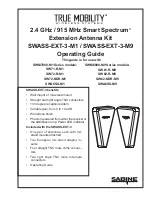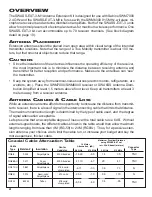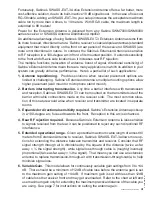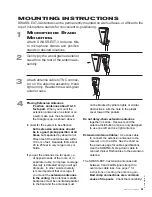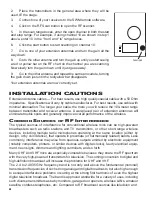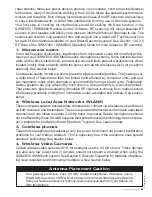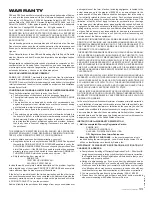
9
LIT-SWASS-EXT-3-OP-080625.indd
©
2008
Sabine,
Inc
1. Microwave ovens
In the vast majority of situations, interference from microwave ovens will not affect perfor
-
mance of your SWM7000 / SWM6000 series microphone systems. Since barriers such as
walls work to block interference, a microwave oven will likely present a problem only when
located in fairly close proximity within the same room as the wireless receiver (or reception
antenna). See caution below.
Commercial quality microwave ovens present a bigger potential problem. They sweep over
a wider band of frequencies than the limited band affected by consumer units, and use
two magnetron tubes which alternate to avoid inactivity during a power cycle. Fortunately,
Sabine systems are only affected by such ovens in close proximity to receiver antennas.
That protection, plus the availability of multiple RF channels to choose from, makes serious
interference problems arising from microwave ovens avoidable and unlikely. See caution
below.
2. Wireless Local Area Networks (WLANS)
These computer network devices allow computers to connect via wireless devices that act
as both receivers and transmitters. These low-powered transceivers often have selectable
channels and can utilize the entire 2.4 GHz band. In general, Sabine microphones should
not be affected by these WLANS because their spread spectrum technology does not pres
-
ent a problem for the Sabine Smart Spectrum
TM
system. See caution below.
3. Cordless phones
These home telephones broadcast at very low power and should not present interference
problems for your Sabine wireless. This is especially true if the telephone uses spread
spectrum technology. See caution below.
4. Wireless Video Cameras
Certain wireless video cameras (X10, for example) use the 2.4 GHz band. These devices
are also very low power and, in general, should not present a problem when using the
SWM7000 / SWM6000 system. See Section 5 Receiver Operation for methods of optimiz
-
ing clear reception and minimizing interference. See caution below.
As a general precaution, keep 2.4 GHz cordless telephones, microwave ovens,
WLAN antennas and 2.4 GHz wireless video camera transmitters twice the distance
from your Sabine wireless microphone system antennas as that of your Sabine 2.4
GHz transmitters.
Antenna Placement Caution
2009
LIT-SWASS-EXT-3-OP-092508.indd
radio stations, these low power devices produce very localized, short range interference;
furthermore, many of the devices working in the 2.4 GHz range use spread spectrum trans
-
mission and reception. Both of these facts mean such uses of the RF spectrum are less likely
to cause interference with, or suffer from interference from the use of, Sabine’s systems.
Your first step in checking for interference should be utilizing the Scan function in the
SWM7000 / SWM6000 Remote Control Software. RF scanning will reveal potential RF
sources in your location and allow you to make an informed choice of channels to use. The
scanner can scan for long periods of time and will give you a report of RF activity over time
for each of the channels available on your Smart Spectrum system. See Section 13.4.2.5
RF Scan of the SWM7000 / SWM6000 Operating Guide for more details on RF scanning.

